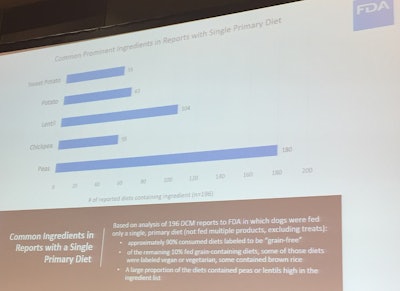
In its ongoing investigation into atypical cases of canine dilated cardiomyopathy (DCM) possibly related to grain-free pet food ingredients, the Food and Drug Administration (FDA) is asking the industry for information related to changes in ingredients, processing or formulation.
David Edwards, Ph.D., an officer with FDA’s Center for Veterinary Medicine (CVM)’s Office of Surveillance and Compliance, presented an updated on the agency’s DCM investigation during the American Feed Industry Association’s 12th Annual Pet Food Conference, held February 12 in conjunction with the International Production and Processing Expo in Atlanta, Georgia, USA.
What FDA needs from pet food industry
Specifically, Edwards said, CVM needs information from pet food producers relative to the timeframe when most of the new cases of DCM were reported over the past few years, but mainly during 2018. He asked for input on changes in ingredients used, sourcing of ingredients, processing or formulation.
He also asked that pet food companies, academic programs and organizations such as the Pet Food Institute continue their own investigations on any potential issues with formulas and ingredients possibly related to this DCM situation.
Wide range of dogs reported among DCM cases
Through November 30, 2018, CVM had recorded 290 cases of DCM involving 325 dogs (plus a few cats) and 74 pet deaths, Edwards reported. The cases occurred from 2014 through 2018, but most were in 2018. He also presented demographic information showing a wide range of affected pets. For example, the most frequently reported dog breed was Golden Retrievers, with 61 dogs affected, while another 27 were mixed-breed and 25 were Labrador Retrievers. Other breeds with numbers in the double digits included Great Danes at 16 and Australian Shepherds at 11; Edwards listed 15 other breeds with three to nine dogs affected each.
Related to the variety of breeds affected, the dogs’ weight ranged from 8 to 212 pounds, with a mean of 68 pounds. They ranged in age from 0.42 to 16 years, with a mean of 6.5 years; 59 percent were male, 41 percent female.
Among the cats affected, ages ranged from 0.4 to 12 years; the mean was 5.5 years old. Their weight ranged from 7 to 13 pounds, with a mean of 11 pounds. The cats were 60 percent male, 40 percent female.
Dog foods and ingredients in DCM reports
Edwards also presented data on the types of dog foods and their ingredients in the reported DCM cases. The foods were predominantly dry (269 of the reports), with four raw and one each of wet and semi-moist. In 14 reports, multiple formulations were named; in five others, the foods were unknown.
Then Edwards provided a deeper dive into the formulations and ingredients for 196 of the reports, in which the affected dogs were fed a single, primary dog food:
- About 90 percent of the diets were labeled grain free;
- Of the other 10 percent of the foods, some were labeled vegan or vegetarian, while some contained brown rice;
- A large proportion of the foods contained peas or lentils high on the ingredients list. In fact, peas appeared in 180 of the dog foods named in these 196 reports and lentils in 104 of the foods. Other ingredients presented by Edwards included potatoes, in 63 of the diets, plus sweet potatoes and chickpeas, each in 55 of the diets.
Edwards said that, before FDA issued its alert about these cases of DCM in July 2018, the agency had investigated for contaminants such as metals or improper levels of minerals and other nutrients in the cases reported to date. After the alert came out, FDA then bought some of the products named in the reports and tested them specifically for those same factors, among other things. All the tests before and after the alert were negative.
FDA is continuing its investigation, working with scientists and nutritionists in the Veterinary Laboratory and Investigation Response Network (Vet-LIRN), and also with veterinary cardiologists. The investigation has included nutritional and amino acid analyses of the foods reported and complete health histories of many of the dogs, Edwards said.

















